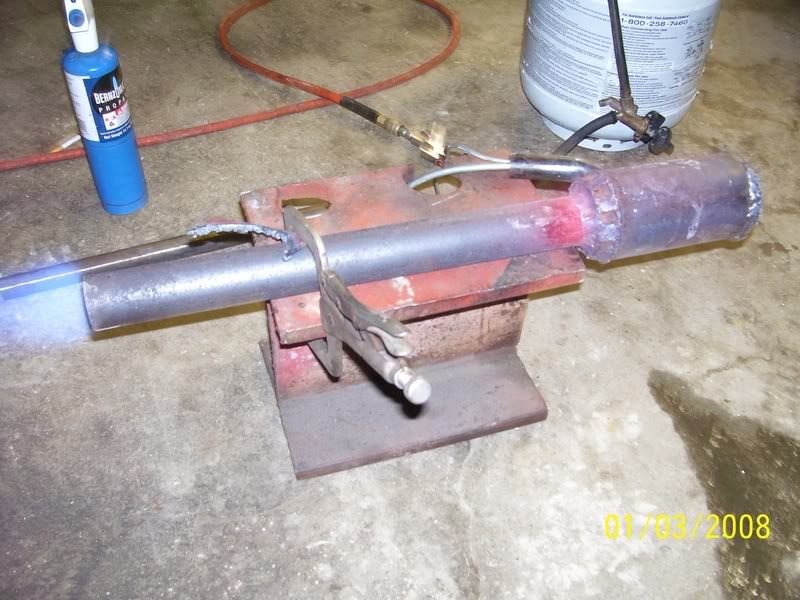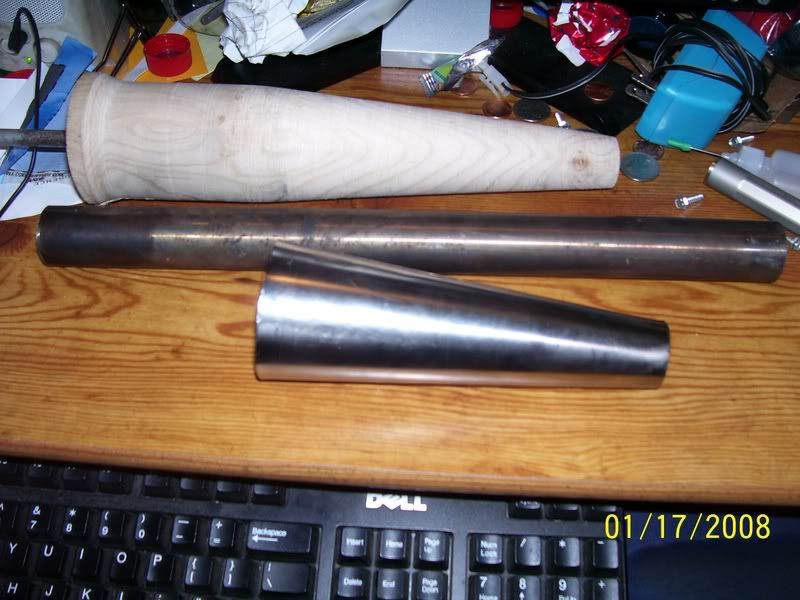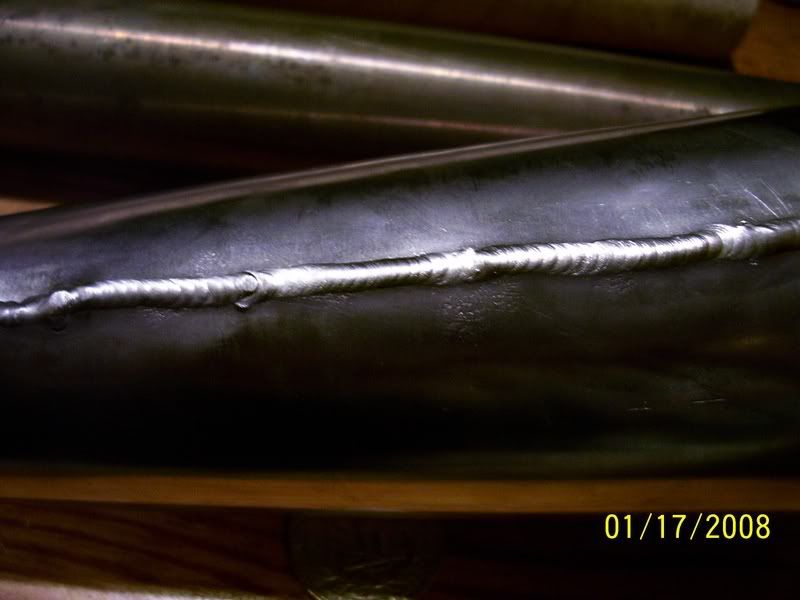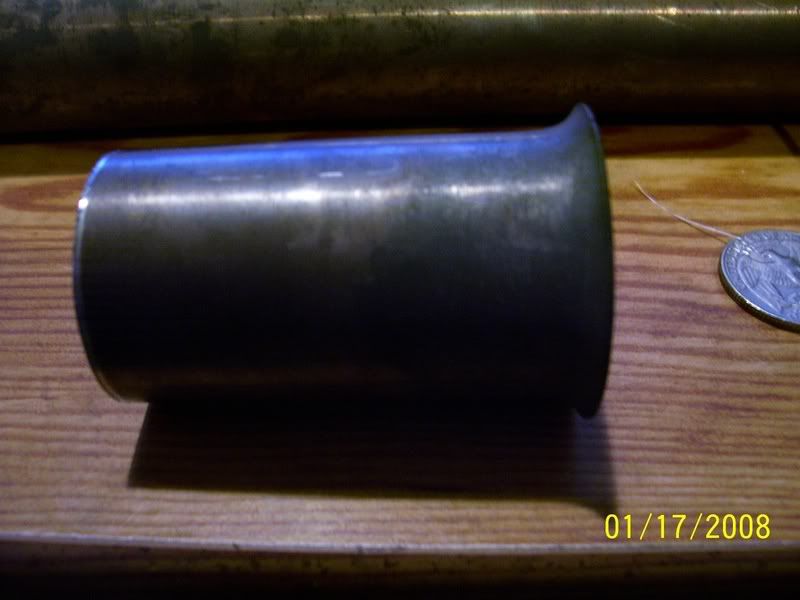| | #1 |
| Rock Crawler Join Date: Feb 2006 Location: Easthampton
Posts: 747
|
Any of you ever seen these before? They are a type of Jet engine. I've been building and running them for a couple of weeks now. Now Im in the process of building a Focused Wave Engine using the plans on the Beck-technologies site, out of Tig welded 304 stainless.Just trying to find some 13/16' tube for the intake, then I'll be all ready to weld it. I dont have access to a set of rollers or big flaring set, so I turned to my metal lathe. , so making the combustion chamber and flares was tricky but I nailed it. Using a wooden form I turned down on the lathe, I cut out the steel and then began rolling it around the form, it came out perfect. Then to make the flares I put a piece into the chuck, and brought over the oxy/act torch. Inserted a piece of solid stainless rod into the tool holder, heated up the tube and began the flaring. It worked great! Here are some pics  and my progress on my new one    Im gonna go out right now and get a video of mine running |
| |  |
| Sponsored Links | |
| | #2 |
| Newbie Join Date: Jan 2008 Location: Waynesville, OH
Posts: 32
|
nice welds but what exactly is this used for?
|
| |  |
| | #3 |
| Newbie Join Date: Nov 2007 Location: Orange
Posts: 8
|
Are they good for crawling?
|
| |  |
| | #4 |
| Newbie Join Date: Feb 2006 Location: Soldotna
Posts: 41
|
How much thrust are getting out of them? Looks good, want to see the video! |
| |  |
| | #5 |
| Official Cook of the ECC  Join Date: Dec 2005 Location: Hawthorne, Florida
Posts: 2,653
|
I've seen some vids of those things. Definately cool.  |
| |  |
| | #6 | |
| Rock Crawler Join Date: Feb 2006 Location: Easthampton
Posts: 747
| They are the simplest form of jet propulsion, they create power with zero moving or vibrating parts. They were the engine that was on the German V1 bombs, also called "buzz bombs" due to the way that they sound when running. nope lol Quote:
Heres a quick rundown of how they work(taken from the wikipedia site) The "valveless" pulsejet is not really valveless — it just uses the mass of air in the intake tube as its valve, in place of a mechanical valve. It cannot do this without moving the intake air outward, and this volume of air itself has significant mass, just as the air in the tailpipe does — therefore, it is not blown away instantly by the deflagration but is accelerated over a significant fraction of the cycle time. In all known successful valveless pulsejet designs, the intake air mass is a small fraction of the tailpipe air mass (due to the smaller dimensions of the intake duct). This means that the intake air mass will be cleared out of contact with the body of the engine faster than the tailpipe mass will. The carefully designed imbalance of these two air masses is important for the proper timing of all parts of the cycle. When the deflagration begins, a zone of significantly elevated pressure travels outward through both air masses as a "compression wave". This wave moves at the speed of sound through both the intake and tailpipe air masses. (Because these air masses are significantly elevated in temperature as a result of earlier cycles, the speed of sound in them is much higher than it would be in normal outdoor air.) When a compression wave reaches the open end of either tube, a low pressure "rarefaction wave" starts back in the opposite direction, as if "reflected" by the open end. This low pressure region returning to the combustion zone is, in fact, the internal mechanism of the Kadenacy effect. There will be no "breathing" of fresh air into the combustion zone until the arrival of the rarefaction wave. The wave motion through the air masses should not be confused with the separate motions of the masses themselves. At the start of deflagration, the pressure wave immediately moves through both air masses, while the gas expansion (due to combustion heat) is just beginning in the combustion zone. The intake air mass will be rapidly accelerated outward behind the pressure wave, because its mass is relatively small. The tailpipe air mass will follow the outgoing pressure wave much more slowly. Also, the eventual flow reversal will take place much sooner in the intake, due to its smaller air mass. The timing of the wave motions is determined basically by the lengths of the intake and main tube of the engine; the timing of mass motions is determined mostly by the volumes and exact shapes of these sections. Both are affected by local gas temperatures. In the valveless engine, there will actually be two arrivals of rarefaction waves — first, from the intake and then from the tailpipe. In typical valveless designs, the wave that comes back from the intake will be relatively weak. Its main effect is to begin flow reversal in the intake itself, in effect "pre-loading" the intake duct with fresh outdoor air. The actual "breathing" of the engine as a whole will not begin in earnest until the major low pressure wave from the tailpipe reaches the combustion zone. Once that happens, significant flow reversal begins, driven by the drop in combustion zone pressure. During this phase, too, there is a difference in action between the very different masses in the intake and tailpipe. The intake air mass is again fairly low, but it now almost totally consists of outside air; therefore, fresh air is available almost immediately to begin re-filling the combustion zone from the front. The tailpipe air mass is also pulled, eventually reversing direction as well. The tailpipe will never be completely purged of hot combustion gases, but at reversal it will be easily able to pull in fresh air from all sides around the tailpipe opening, so its contained mass will be gradually increasing until the next deflagration event. As air flows rapidly into the combustion zone, the rarefaction wave is reflected rearward by the front of the engine body, and as it moves rearward the air density in the combustion zone naturally rises until the pressure of the air/fuel mixture reaches a value where deflagration can again commence. Im working on uploading the vid now | |
| |  |
| | #7 |
| Rock Crawler Join Date: Feb 2006 Location: Easthampton
Posts: 747
|
Heres the video, sorry about how dark it was, I'll try to take another one tomorrow after I get home from snowmobiling. At least you can hear what they sound like. Thats about 400-450 hertz, or 400-450 explosions per second  |
| |  |
| | #8 |
| Quarry Creeper Join Date: Aug 2006 Location: NORTH TEXAS
Posts: 202
|
Very cool! can you adjust the fuel flow to act as a throttle. |
| |  |
 |
| |